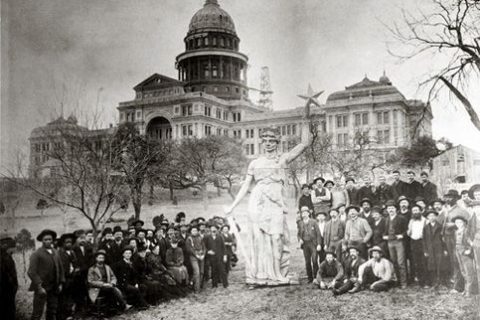Florida’s reputation precedes it. A quirky history which led to a bizarre amalgamation of dichotomized peoples, the state titers on the edge of both the Left and the Right. Initially a disparate backwater of the Spanish Empire, the state changed hands several times in its colonial history, eventually nestling in the United States of America. A vast land with a seldom matched ecological beauty, large lowland hardwood forests, swamps, coastal plains, and hot, yet hospitable weather, welcomed those seeking fortune on the frontier and inspired awe in the eyes of early Europeans settlers. Featuring a strange conglomeration of groups, stemming from Spaniards in the old Spanish Colonies, a multitude of runaway slaves and criminals from the pre-state period, Appalachians moving through Georgia, Anglo slave lords, Negro slaves, and a constant stream of early statehood land prospectors and surveyors, Floridians never belonged primarily to one particular ethnic group yet managed to develop into a largely Jacksonian Democrat state politically, albeit with the smallest population within the entire Confederacy. This frontier sentiment would lead to a Reconstruction moored in political gridlock and wanton violence. This essay will examine the economic, political, and social Reconstruction of Florida.
The economy of Florida survived largely intact. Though, of course, financially destitute as a default of wartime loss, Florida’s miniscule infrastructure and cities stood intact due to a lack of internal Union invasion, excepting a few coastal cities. Additionally, the Union forces within the state were not wont to raze and destroy the cities they successfully held. The real internal damages came from the numerous raiding parties which ventured forth from the Federal strongholds. Quickly blockading Florida’s coasts, Union forces occupied ports in Apalachicola, Cedar Key, Jacksonville, Key West, St. Augustine, and Pensacola by 1862. Though these forces would eventually gain continued footholds in other coastal cities, they never truly conquered the interior, only seizing the capitol by the War’s end. From these locales the aforementioned raiders would loot and destroy local property. An influx of marauders and wildmen, as well as, a general increase in lawlessness resulted in slaves simply leaving plantations and armed robbery running amok, further hindering economic affairs.
Even following the War, Florida would remain both agrarian and untamed until the 1920s, as a result of carpetbagging tourists, a trend which began during Reconstruction but took a few decades to reach full realization. Through the timber industry, moderate governorship of Harrison Reed during the brunt of Florida’s Reconstruction, and numerous ports would allow a modicum of financial recovery, the Radicals’ spike increase in expenditures would add further hardship to the tax burden of White landowners.
Political circumstances ran generally par for the course, albeit less eventfully regarding Florida’s adjacency to the Lower South, owing in large part to the compliance of Floridians. David Walker was quickly elected Governor in December 1865. Walker governed moderately and worked diligently to have the state readmitted to the Union. Interestingly, he was not removed from office after the passage of the Reconstruction Acts of 1867. He would prove a decent governor, but would become embroiled in the tumultuous Constitutional Convention of 1868.
The convention itself began as a mere drafting of the state’s new constitution. Beginning as a standard Reconstruction affair, the divide between moderate and Radical Republican quickly became apparent. The moderates would eventually storm out of the state capital of Tallahassee, and relocated to Monticello. After each faction drafted its own constitution and submitted them, military intervention would force the two groups to reconvene together. The Monticello Constitution was ultimately chosen for vote and thereon ratified in 1868.
Following that period of chaos, Harrison Reed succeeded Walker as governor in July 1868. Reed would serve until January 1873, and to the benefit of Floridians, he was an unwavering moderate. For Reed, this would create unrelenting battles between himself, the Democrats, and the Radicals. Ultimately, this contention would lead to four separate impeachment attempts against Reed, all of which failed. Credit given where it is due, Reed, despite being a Republican and having no political friends, dissuaded corruption and attempted to rein in the Radical elements of government to the best of his ability.
Not being popular, Reed would fail reelection. The governorship was assumed by Ossian Hart in January 1873. Little may be stated of Hart’s tenure. During his brief governorship, he fell ill. Developing pneumonia, Hart would succumb to the disease and die on March 18, 1874. Hart’s successor, Marcellus Stearns, would only complete the remainder of Hart’s term. Stearns would continue Reconstruction as usual. Much like Hart, Stearns’ term is not all too remarkable. He would be the last Republican governor of Florida until 1967.
The gubernatorial election of 1876 would prove the moment to finally “Redeem” Florida. Both the Democrats and Republicans put everything they could behind the election, but the Democrats went a step further. Organizing at every level, Democratic Whites disregarded the federal suppression of lawless violence and began enacting tactics of intimidation, ballot stuffing, threatening termination or forced removal of living place, and voter fraud. Though election day itself passed largely without incident, the campaign was tumultuous. Both sides would accuse the other of fraud, but the craftiness of the Republicans would result in a win for them both in the gubernatorial election and the presidential election. However, the Democrats refused to concede. After a period of legal challenges, the state supreme court declared the Democrat George Franklin Drew the winner of the gubernatorial election. Despite a positive turn of events for White Democrats, the electoral votes would still be counted for the Republicans. To that extent, the political Reconstruction of Florida came to an end in 1876.
The War never spent much time encroaching on Floridian soil, in regards to full invasion that is. A state filled with Jacksonian Democrats, both poor and planter, it leapt at the chance of secession, often suppressing the will of the minority Unionist factions. The Florida Unionists began small and remained small throughout the War’s duration, and the faction was generally comprised of foreigners, Yankees, and resentful poor Whites. However, the latter class usually sided with Secessionists more often than not, and the Unionist members among them were nominal. If nothing else, poor Whites, who owned few or no slaves at all, tended to embrace sectional animosity and understood the societal reliance on the well being of the Cotton Kingdom as well as simply conforming to the popular norms of the time.
Initial societal sentiments differed from the sentiments among sister Confederate states upon the War’s conclusion. Though an irascible, Jacksonian bunch, Floridians approached cessation of hostilities in an odd manner. Unlike Mississippi, South Carolina, East Texas, and Louisiana, Floridians generally desired peace and reconciliation, regardless of how ardently pro-Confederate. However, the dolorous circumstances of a defeated population, freed Negroes, and supercilious Yankees would ultimately turn the state towards more extreme solutions.
Though the politics of Reconstruction in Florida developed unremarkably, the social factors at play tended to resemble restlessness and the macabre. The post-War years turned Floridians toward a darker resolve. Resentment over the War’s loss and Union raids during the War, roaming Freedmen, Negro troops, unending federal occupation since the War’s end, and the Reconstruction government’s inability to establish law and order in numerous counties produced a volatile powder keg on the verge of ignition. It may also be stated the effect of no law and order on the human psyche. All possible reasonings aside for why the violence unfolded, it may simply be stated the character of many is towards brutish behavior without any prerequisite necessary for them to act in such a manner.
Lawlessness remained a consistent problem throughout Reconstruction. General criminal activity would continue unabated throughout the period. The state government, mainly the government of Governor Reed, lacked the manpower to effectively quell illegal pursuits. However, the racial character of the crimes developed as time passed. Several counties were engulfed in such circumstances. The racial violence grew to such an extreme in the panhandle that one such county would cause what is now known as the Jackson County War to unfold. It was not so much a war as it was general racial animosity. Several high profile murders perpetrated by both Whites and Negroes took place. The local sheriff would resign in 1871 due to the impossibility of administering justice, and locals were so hostile to the law that they often refused to act in its favor. By the end, it is estimated anywhere between 100 and 200, if not more, “leading Republicans” were murdered in Jackson County between 1868 and 1871, and more unknown individuals may have perished, a high number considering the small population at the time. By 1871, the counties with the most unrest included: Jackson, Alachua, Madison, Columbia, Hernando, Lafayette, Calhoun, Suwanee, and Hamilton.
A number of these vigilante groups may be named and identified. The obvious and most notorious of these was the Ku Klux Klan. Contrary to popular opinion, little recorded evidence exists pertaining to their presence in Florida during Reconstruction. Other organizations were the various rifle clubs, the Union Leagues, Lincoln Brotherhoods, and the Young Men’s Democratic Club, alongside various individuals who committed crimes, regardless of color. However, one group stood above the rest in Florida. The “Regulators” were White militia and vigilante groups which often conducted various acts similar to those seen in other organizations, but they leaned towards establishment of local order. They derived their name from the Regulators of Florida’s territorial and early statehood days, when law simply did not exist in many areas. Much of this sort of activity ceased altogether by 1871, once the federal government strengthened its military and judicial grip on the state after the passage of the Reconstruction Acts of 1871. A spike in political violence would occur once more in 1876 and thereafter cease upon the gubernatorial election’s conclusion.
The breathtaking splendor of Florida’s sublime ecosystem drew some of the earliest European settlement in North America, primarily Spaniards. The vast swathes of fertile virgin land and disparate population attracted a conglomeration of swarthy folks seeking fortune or escaping Planter society and the law. Fueled by reactionary sentiments, the state would quickly embroil itself in war, then prove itself longsuffering as one of the last Southern states to achieve Redemption. The economic, political, and social ramifications of the War and Reconstruction would leave a lasting legacy for which parts of the state has never truly recovered. While the flood of carpetbaggers would never cease after Redemption, a group which continues to wreck havoc across the Sunshine State while also neglecting its rural, northern regions, Florida, at least at the time, grasped a modicum of respite from the clutches of Radical ambitions.
“The White people of the South are the greatest minority in this nation. They deserve consideration and understanding instead of the persecution of twisted propaganda.” –Strom Thurmond





